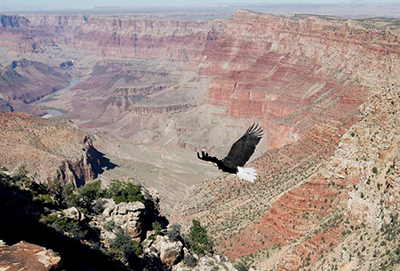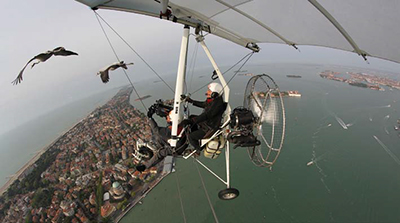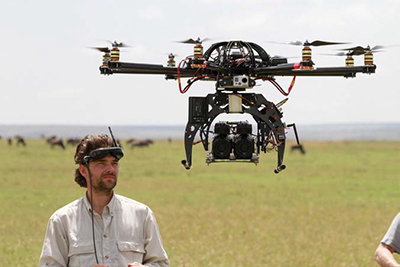Pushing Technical Boundaries With ‘Earthflight’

A small camera was attached to bald eagle to capture a bird’s eye view of the Grand Canyon.
JACKSON HOLE, WYO.—At the 2013 Jackson Hole Wildlife Film Festival, “Earthflight,” a six-part series produced for the BBC and aired on PBS last Fall, received a special jury award for technical achievement. It also recently received an Emmy for cinematography in the News and Documentary category and likely will earn many more awards over time for its jaw-dropping cinematography.
“Earthflight” takes the viewer soaring heavenward into migration milestones and rare avian assemblies around the globe. Moreover, it employs every feasible technological trick of the trade to immerse the viewer in the aerial action so that they feel like they’re soaring and flapping with the eagles, condors and other great birds featured, so that “it’s just like being there,” as co-production partner Discovery Channels likes to boast.
GLOBAL IN SCALE
Underpinning this hi-tech tour de force is Executive Producer, John Downer’s commitment “to use the best technology available at the moment” to tell his ambitious story. “With ‘Earthflight,’ I wanted to push the technical boundaries and do something global in scale. The natural events and wildlife of each continent, seen from the viewpoint of migrating birds, seemed the best, natural way to do so,” he said.
For starters, Downer planned to update techniques developed for a program on birds in flight, produced earlier in his career, by taking full advantage of technological advances since then. “When shooting 10-minute rolls of film, the camera always seemed to run out just when things started happening,” he said. “With today’s digital cinema cameras that rarely happens, but there are always new challenges. In our first year of filming, we had chronic problems with dropped frames due to vibration of the hard drives while filming in ultra-lites.”

Philip Dalton piloting the Octocopter carrying a 3D rig in the Masai Mara, Kenya. Curiously, “Earthflight”’s four-year long production timetable became a major asset by giving technology a chance to catch up to meet Downers’ goals. “At the very start we had little of the technology we came to count on,” he said. “But we knew it was coming and so planned our production schedule with that in mind. If the technical advances hadn’t arrived as promised, we’d have a very different show. We started without a main digital cine camera that could even shoot much above 25 fps, hence, Red One made a big difference with 60p.”
Luckily for Downer, Red Digital introduced its Red Epic midway into the series. “Red Epics were huge, by giving us most of the frame rates we needed in one camera,” he said. “Its larger format added stabilization and allowed us to get multiple shots out of one, by cropping the frame.”
Get the TV Tech Newsletter
The professional video industry's #1 source for news, trends and product and tech information. Sign up below.
The ability to “overcrank” Epics to 240 fps in HD meant that they could use it to capture much of the breathtaking slow-motion imagery of birds in flight that became Earthflight’s signature. However, even 240 fps wasn’t fast enough to slow down water droplets bouncing off the wings of imprinted (barnacle) geese, flying in formation with Downer’s ultra-lite. “That’s where the Photrons and [Vision Research] Phantoms with 1000 fps were invaluable,” said Senior Producer Philip Dalton. “We mostly used Photrons which combined ultra high-speed with high optical quality and dependability, plus were more affordable for long stints afield.
“However, the Phantom has a large magazine [drive] that enables you to capture several minutes of footage at the highest speeds and resolution speeds before filling up the hard drive,” Dalton continued. “With the Photron we were limited to a minute or so at 1000 fps before having to offload. But with pre-roll that’s often enough for several shots. Plus you can preview in the field and quickly delete inferior shots in the camera, to shoot longer between downloads.”
UNIQUE PERSPECTIVE
POV cameras were also key to capturing an intimate portrait of mass bird movements across the continents, from the perspective of individual birds, according to Dalton.
“Initially we downsized smaller AVCHD camcorders to attach to large birds like condors, eagles and African vultures in order to capture their lofty perspective,” he said. “Initially we modified Sony EX1s, but shifted to Canon XF 305s and 105s once they became available. We also mounted Canon 5Ds on miniature gliders, including our ‘VultureCam’ to film our target birds in flight, at very close range.”
Downer’s team also used Canon XF105s and 305s as remote camouflage-cams by inserting them into rocks, stumps, and even carcasses and operating them with customized pan-tilt controls. Towards the end of production they increasingly deployed GoPros as “critter-cams.” “Miniature cameras have gotten better and lighter, rapidly,” Dalton said. “Unfortunately GoPro3s came in a bit late in the day for us. But GoPro2s made it much easier to mount an HD camera on a flying bird. We used them a fair bit in our last year of production.”
3D Version Coming
JACKSON HOLE, WYO.—John Downer’s team used RUVs, high-speed cameras, 2D and 3D cameras shot from ultralites, (as well as on the ground, mounted on tripods, jibs, and handheld), and sometimes POV cameras mounted on birds in Panama City to capture tens of thousands of hawks overflying it one peak day. In Africa they used RUVs to capture low, slow aerials of lions and crocodiles hunting, plus dense flocks of flamingos feeding and nesting on treacherous alkali lakes.

Philip Dalton uses video goggles to assess 3D footage acquired by a drone.
“We also used them to capture slow, low-angle ‘dolly shots’ over Victoria Falls in Africa and Angel Falls in Argentina,” Dalton said. “Moreover, since they’re much quieter than helicopters they generally don’t spook wildlife and sometimes even pique their curiosity.”
After completing much of their 2D production schedule Downer shifted to capturing as much as possible in 3D, including reshooting some species and spectacles over again.
“In order to properly capture the full impact of some of the spectacles we’d already filmed, we built our own parallel 3D rigs and began shooting a great deal in 3D, towards the end,” Downer said. “We even mounted the Photrons on our 3D rigs and managed to sync them well enough as well as getting impressive 3D results with twin 800 mm Nikon lenses and Flare cameras, even though telephoto and 3D are supposed to be mutually exclusive.”
One version of their 3D effort will air on 3Net within the next month, while a theatrical release is also planned for 2014.
—Carl Mrozek
The ability to deploy HD cameras on remote unmanned vehicles, i.e. “drones,” added another key dimension to their ability to capture the drama of bird migration across the globe and of bird flight in general, from a bird’s eye viewpoint, according to Dalton.
“We used RUVs, especially multicopters, a great deal in our last year of production,” he said. “In Italy we used them to film the aerial gyrations of huge flocks of starlings evading falcons. In Istanbul we used several, plus ultra-lites and gliders to capture a spectacular peak day of hawk migration over this ancient city. We used every tool we had to fully capture this unique, fleeting spectacle, as we often did with Earthflight shoots.”
While Dalton’s team custom-designed multi-bladed drones mainly with components by German-based Mikro-Kopter, today, smaller, standardized RUVs by Asian companies like DJI, are readily available and more affordable.
“Drones have really come on strong in the last 18 months or so,” Dalton said. “The newer, mass-produced RUVs are actually more stable and much easier to assemble and control than those we used. Their payloads are smaller too, but they’re fine for GoPros and even digital cameras like the Lumix.”
In terms of drone use, Downer and company were fortunate to have done their North American shooting early on with most of their shooting outside the United States, where drones cannot be legally flown without a license, and commercial licenses are not yet available. This frustrates wildlife shooters like Kennan Ward who experimented with drones early on, but now can’t put the technology into practice in his wildlife work in the U.S. for another year or so.
“For the next year or two we’re restricted to private property until the FAA writes the rules for commercial pilot’s licenses, and hopefully makes them affordable for small operators like me,” Ward said. “The only ones who can afford the permits now available are Hollywood-sized production companies.”
Ward agrees with the need for rules and regulations for RUVs, particularly for use with wildlife. “‘Pro is slow,’” Ward quipped. “The reaction of most animals to RUVs, is ‘fight or flight.’ If you speed into an animal, it’s gone. If it looks like a rock and moves glacially, you have a better chance. Nevertheless, it is still illegal to operate them today—at a certain altitude— other than on private property.”
